
New Islands and Old Idols - Blackwall to Dagenham
Posted in London on Saturday 20th May 2017 at 10:05pm
The luxury of waking in London wasn't lost on me this morning. As I tramped towards an early breakfast which I took with a view over the Tower of London and bright sunlight glaring off the panels of The Shard, I pondered the day ahead and its odd division between places old and new. I've walked and written about London and its environs for years in some way, but there was a distinct tempo change in 2012 when I felt like the city was on the brink of its next seismic lurch into the future. It was a tumultuous year in many ways - in London, in the wider world and in my own life - and I noted a distinct shift in how I was thinking and writing about the city. My rambles became longer, and with them my ramblings grew too. I also began to circle further and further from the well-beaten tracks in the centre of the city. Slowly, chaotically, and in sometimes stuttering steps I grew to knew the fringes of the city which I'd previously only experienced from the windows of passing trains. When my sense of adventure failed me and I felt I'd pushed the boundaries far enough I'd scurry back to safety to scratchily write up a breathless account of my walks. For the first part of my day, I'd decided the time was right to revisit some of the locations where I'd begun to explore the edges of the city. Breakfast done I hopped onto a No.15 bound for Blackwall and followed the familiar route of the A13 out of the city and into Limehouse. There was enough cool breeze to prevent the morning from being too hot, and I wondered why I'd bothered loading my coat into my bag. A quick stop on Poplar High Street for provisions and I set off into familiar territory...
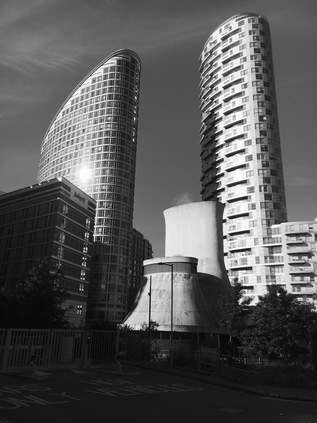
I remember lingering longer than I'd planned in Blackwall on my last visit. I'd been struck by the new city of towers rising on the fringes of Docklands, leering over the elevated DLR tracks and the angular horseshoe of Robin Hood Gardens. I hadn't expected the shift in scale between Poplar High Street and these new developments and today, with many of the cranes gone and the towers looming towards the impossibly blue sky, the effect was even more surprising. I found myself wheeling around snapping pictures of the curious views again, realising that I was probably duplicating many photographs I'd taken before. On my last visit I'd sought the river - but the aim this time was to cut across Blackwall to reach Leamouth. I was soon at the familiar roundabout at the foot of the Lower Lea Crossing - a bridge I'd seen as an impassible barrier at one time. I thought back over the many barriers I'd considered the end of London over the years, and how dark and empty the map of the East had seemed at first. Now it was rich with meaning and experience, and this felt like a gateway rather than a barrier. Today though, I didn't need to take the crossing. Slipping away beside the arc of the bridge, I headed towards Orchard Place. The urge to detour into Trinity Buoy Wharf again was strong, but there was somewhere I'd not been able to get to on my previous visit - one of the many inaccessible sections of the Lower Lea which had been, for myriad reasons, been put beyond limits for the pedestrian. Now it was, nominally at least, open again. To reach my goal though, I needed to navigate City Island - London's 'newest island' according to the glossy displays of happy, wealthy people grinning manically at each other along the wooden hoardings that still enveloped a large part of the site. In truth of course this is neither an island, nor in the city. This isthmus, one of the bulging diverticula which contort the Lea as it becomes Bow Creek, had been a place of considerable industry: glass, paraffin, plastics, naptha, tar and finally hydrogenated fats. The industries which had shadowed Orchard Place shared a couple of key characteristics - pungent fumes and lingering toxins. Now, as I tried to navigate around the entrance to the site without trangressing on some unwritten regulations which the security staff appeared to want me to obey via psychic divination, it wasn't hard to imagine the clutch of chimneys emitting a pall of darkness - the new towers rising on the peninsula stood in for them remarkably convincingly. I shuffled into the main square where the developer had, in lieu of any other stores this side of the river, set up The Grocer. What was dressed in the livery of a high-end emporium was really an expensive corner shop, with an attached but closed restaurant. A few other walkers, apparently from the blocks already completed on site, joined me as we followed the authorised route out to the western edge of the bulge in the river, following its curve towards the new bright red bridge to Canning Town. Across the water I could see the path along Silvocea Way leading to the footbridge I'd crossed before, standing beside the old iron bridge which seemed to rust even more before my eyes. I soon reached the stairs and lift leading to the tall new bridge, hanging back long enough to have the freedom to take pictures without annoying the locals. From the deck of the bridge I had a broad sweeping northern view dominated by the A13 crossing the Lea and the silhouette of Balfron Tower. Looking back towards the 'island', the knot of new buildings eclipsed the sun, the blocks unlit but bathed in a bright halo. I descended to the far bank near the rotunda leading into Canning Town station. Here I headed along the previously forbidden path on the northern bank of the river. My plan was to cross the DLR via an austere, metal-gridded footbridge and head into the industrial zone which lined the valley floor, but once over the bridge and on the descent to Wharfside Road, I noted the gate was locked at the other end. I could retrace my steps over the rails and trek around the long looping path through Bow Creek Ecology Park, or I could head out into Canning Town via the station and regain my route from there. Amused that finally accessing Orchard Place had led me to this rather pointless barrier, I headed for the station. It seems there was one sanctioned route off the island: directly to the transport interchange without looking around for fear the true nature of the river might be divined. God forbid that the new islanders found out what horrors lurked on the northern margins of their new home, or strayed east to ill-governed Rathbone Market. The island was a defensive position, surrounded by potential danger.
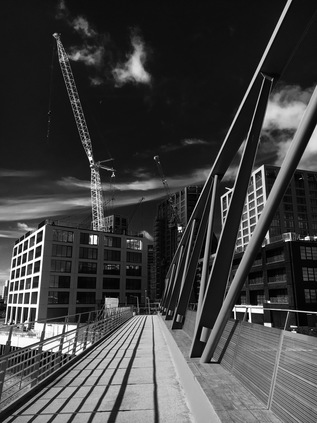
I carefully negotiated the complex crossings of Barking Road. Here the more recent course of the A13 thunders overhead to bypass Canning Town, while its old route continues an ancient eastern line towards the Roding Valley. The junction was a windswept and dusty spot, but I knew conditions would only get less pleasant as I continued in this direction. On the corner of Stephenson Street, much improved by a new road surface replacing the cracked and chemically melted tarmac I'd stumbled over before, was a convincing Paris Metropolitain entrance set into the wall. This curious doorway led into the location of the most recent Secret Cinema event - and it seems that somewhere in the apparently abandoned branch of Carpet Right was a recreation of Belle Epoque era Montmartre. There was no external evidence of this as I headed around the corner into the long, straight channel of filth which continued north towards West Ham, flanking the railway tracks. It was almost reassuring to see that this area hadn't changed a great deal. The Durham Arms still continued in almost invisible business on the corner behind unwashed net curtains, while the tottering stacks of old delivery crates and tractor tyres threatened collapse onto the abandoned Black Cabs and dumped cars with their locks drilled out. The same slow parade of out-of-service buses bucked along the uneven road, kicking up clouds of reeking dust from the dry surface. This area had tested my resolve on my last visit - I'd felt unwelcome and entirely beyond my comfort zone - but when I considered some of the terrain I'd blithely crossed since, I almost laughed at this bit of textbook liminal edgeland. Still, I wasn't unhappy to turn west onto Cody Road which was comparatively quiet and free of dust. I knew that Cody Dock wasn't going to provide access to the river, so instead I made my way into the surprisingly primped and tidy Prologis Business Park, passing the ever-unmanned security point with far less trepidation than before. Here, between the vast bulk of the Sainsbury's Online Fulfilment Centre and the Amazon warehouse, I found the narrow path which led to the bank of the River Lea. At the end of the path a broad arc of benches doubled as the smoking area for the warehouses, a ring of spent butts and ash encircling each seat. The views up and down the river were arresting, as new ways of looking at familiar sights often seem. With both banks largely inaccessible here, I'd only ever approximated a walk along this stretch of the river via nearby roads, and seeing Bow Locks ahead from this unusual angle was disorienting. I continued north: the path was apparently little used and crunched pleasantly beneath my boots. The path is perhaps so poorly used as it doesn't yet go anywhere useful, but slowly the links are being made. The steep but functional Twelvetrees Ramp now finally allows access from this new stretch of path onto the older route between the Lea and the Navigation without a long detour north or south along the Blackwall Tunnel Approach Road. I descended to the familiar route to Three Mills, walking between the waters with the railway bridge reflected from above. I was on well-walked and pleasantly familiar territory once again.
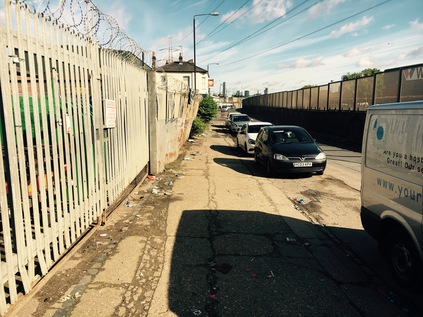
Three Mills Green seemed surprisingly quiet given the weather, but it was of course still early. I took a break here, picking a bench with a view north towards the gleaming steel and glass skyline of Stratford. Every time I passed through, the cluster of towers seemed to have multiplied, and the expansive view north along the Lea Valley seemed to be hemmed in by development. Set against the clear skies though, the city appeared striking and definite - a reality which I'd doubted it would ever achieve when I'd tramped over the dust of the site after the Olympics. After watching a pair of dedicated joggers circling the park for a while, determinedly avoid getting drawn into some sort of low-speed race, I headed towards Three Mills Lock. For years, the bridge here has been a boundary, First LOCOG, then Thames Water - authority has forbidden any access over the bridge and to Long Wall for around ten years. Indeed the nearby at Short Wall path was still blocked near its entrance - though it was less clear why or by whom. I'd read recently that Long Wall had opened again, and given my unusual itinerary today I decided that this missing link would be a fitting target for the first part of my walk. My heart sank at seeing notices with Thames Water insignia stationed at the entrance to the bridge - but these were in fact declaring the way open - ominously for 'the foreseeable future' at least. I crossed the bridge, looking down at the modern, concrete lock from a new angle. I wondered too when it had last opened? Built to enable a sustainable supply chain for the Olympics but never used to let a single barge into the site, the impressive control cabin still appeared to be staffed at times - the detritus of human presence clear in its high windows. At the end of the bridge the path turned a hard right to follow the eastern bank of the Prescott Channel to its confluence with the Channelsea River. Walking this bank seemed strangely defiant after being denied for all these years. The path plunged into the untamed woodland which fringes these rivers, allowing occasional glimpses towards the railway and the gasholders beyond. The Long Wall path was little more than a simple stony track under the trees skirting the former Lee Tunnel building site. It was surprising cool under the green canopy and I slowed my pace to savour this short respite from the noise and dust of London. I'd worried that this short stretch of path would be an insignificant reward for years of waiting - but it wasn't necessary. This was another fine reason to lurk in this strange, disembodied part of London. The path divided, allowing me to take a lower route, nearer to the water. Across the Channelsea was the long island which divided it from Abbey Creek, the strange derelict buildings I'd spied on the aerial photography suddenly real and present. Beyond the creek, Channelsea House rose to dominate the view, much refurbished and not as baleful and desolate as formerly. My path opened into a broad concrete platform where thick, curved iron pipes leapt from the ground to join the Northern Outfall Sewer up ahead. A well made slope took the path to join the Greenway, passing the brightly painted snail-shell turbine casing which I'd seen years ago from the bridge. I was sorry to be at the end of this new path, and almost at the end of this revisiting of the area. It was time to head for West Ham station, a short walk along the sweltering dust of the Greenway.
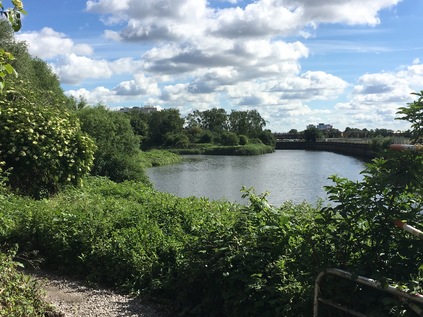
Given my extended day in London, I'd decided to take in another guided walk - this time based around the Industrial history of Dagenham. I've written before about my hesitation in taking guided walks and how I sometimes feel uncomfortably constrained by the idea. But based on the experience of the last trip with Rob Smith as a guide and since I'd had free rein to wander since early morning, today seemed like a good opportunity. Like Rob, the area south of the A13 on the map has been an empty white zone for me and attempts to explore have faltered on the simplest of questions: am I really allowed to be here? The dominance of the Ford Motor Works makes the boundaries hazy and amplifies the always present sense of alienation that these zones create. I'd passed through on the train, or cruised above on the road, and I was none the wiser. Hence the promise of a five mile slog via the white zone to the Thames sounded like a fine way to spend an afternoon. I made a leisurely progress to Dagenham Dock station where I found the group already assembling in the strong sunshine. It wasn't yet noon, and the threat of rain which had forced me to stuff my bag with a coat felt remote. I confess I'd never expected my excursion into the wild, filth-strewn industrial estates of Dagenham to begin with a liberal application of sunscreen, but it was certainly necessary today. Once the group was accounted for we set off, crossing the railway and pausing on the bridge to survey the extent of the Ford works, and to consider its part in the history of equal pay for skilled women workers. Though only greatly reduced activity continues on site, the breathtaking sweep of land which was once dedicated to the manufacture of motorcars was still evident in the abandoned buildings and scorched earth of newly cleared sites. The plans for this area still focus on employment and industry, but with an emphasis on green technology which will at least justify the costly remediation of this poisoned ground. Climbing down to ground level we passed under the concrete viaduct of the A13 before heading down the arrow-straight Chequers Lane towards the river. Buses reaching the end of the line on route EL2 lazily looped around at the end of the road before returning to Barking and Becontree, unsurprisingly running empty for this stretch on a quiet Saturday afternoon. We followed their dusty trail towards the junction with Choats Road, passing the end of Breach Lane. I'd hoped we'd get a glimpse of the elusive lake nestled within the gates of the Ford works, which was created by an inundation of the marshes in 1707. Unfortunately, there was no easy view to be had - but the impact of the breach on the area cropped up throughout the walk - not least in the tales of the botched efforts to restore the river wall and the eventual success of John Perry in staying the waters and removing the growing sandbank in the Thames which the breach had created, and which threatened trade in the London Docks.

It was interesting to watch the reactions of the assembled walkers, interested Londoners and local history buffs as they progressed along the dusty, litter-strewn grid of byways between Barking Reach Power Station and the river. Some appeared to be expecting the odd, quiet desolation while others appeared eager to find any hint of nature as a relief. As we turned into Hindmans Way the road took on a more rural aspect, winding between industrial units like a country lane. Edging around the parked trucks and avoiding the thundering tractor units passing by, we turned a corner and a wide panorama of the Thames opened ahead. From Belvedere in the east to Thamesmead in the west, the south bank felt strangely close, dark clouds rolling over from the west towards us. Closer by were the gates across the jetty of Dagenham Dock which curved out across the sandbanks, rails still embedded in the ground. This felt like a forlorn and desolate place, but the presence of the sluggish, dark river was comforting. We considered Perry's work here - effectively preserving the swathe of Dagenham Marsh which the white space in the A-Z now represented. Near here in 1922, workers had unearthed a wooden anthropomorphic figurine made in about 2500 BCE, later called the Dagenham Idol - tempting though it was to think it today, we certainly weren't the first to walk here.
Unfortunately access along the Thames here is restricted by the Cemex plant and jetty, which cut across the wonderfully named Thunderer Road. This commemorates the building of HMS Thunderer at the Thames Ironworks & Shipbuilding Company, sited close by my morning walk on the Lea. The building of the Orion class Super Dreadnought, launched in 1911, nearly crippled the works as such contracts relied more on patriotic duty than fair remuneration. The works struggled on into 1912, closing after unsuccessfully petitioning War Minister Winston Churchill for more orders to save them. HMS Thunderer went on to have an undistinguished career with the Royal Navy, seeing some action in the Great War but not managing to make the impact expected of her class. The ship was decommissioned and broken up in Rosyth during 1926, attaining one last indignity by running aground on her final voyage. Technology had moved ahead swiftly and left both Thunderer and the Thames Ironworks behind. Back on the seemingly endless Choats Road, the clouds began to close in overhead. A few spits of rain were on the wind as we squeezed through a gateway to a rough public footpath which climbed up a grassy rise beside the deep gully where the Gores Brook emptied into the Thames at a sluice. I'd encountered the Gores Brook tangentially on previous walks in the area, but as much of it sat within this zone, I'd never attempted to follow it. Now it sluggishly made its last exit into the river below us, as we climbed higher onto what was once the spoil from excavating the Bakerloo Line. The area had remained largely derelict since, save for providing the early home for the Handley Page aircraft factory. Following some early and largely unsuccesful experiments in aviation which took place nearby on Dagenham Marsh becoming something of a public spectacle despite their expected secrecy, Sir Frederick Handley Page adapted the Wright Brothers original design and manufactured effective flying machines here before moving to Cricklewood in 1912, abandoning the site to become the wilderness we walked today. But this won't be wildness for long - as this is the furthest extent of Barking Riverside, the vast 11,000 home development which will occupy former industrial land and these areas of 'wasteland' between Barking Creek and the Gores Brook. As we turned the corner onto the wind-blasted green swathe which edged the Thames it was hard to imagine why anyone would want to destroy such great beauty. It was also hard to imagine living out here, nestled between the open sweep of the estuary and the broad industrial plain. Downwind of the various landfill and sewage processing areas, the air had a faint tang of metal and decay even on a breezy spring afternoon. Our group had been chatty and engaged until now, but as the scale and breadth of the view opened everyone fell silent. We were a long straggling line of walkers, making our way along this remote wild edge of things, just yards from one of the biggest industrial areas in Europe.
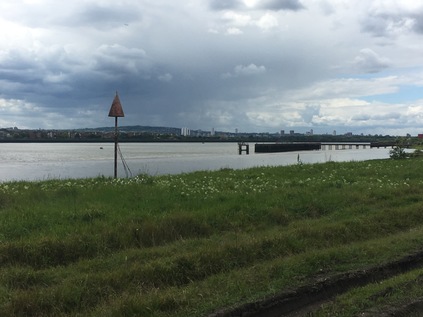
The path ended where another jetty cut across the riverfront, and we were forced to turn inland at the Barking Riverside Visitor Centre. This sustainable and temporary facility built from whitewashed shipping containers attempted to sell the concept of the new urban area from the very centre of the empty space it would one day occupy. An active and malleable imagination was required to see the dream today. We took the opportunity to rest around the gravelled courtyard, or to use the toilet facilities. While we waited to regroup, mostly looking silently across the river to Crossness and beyond, the storm which had rolled over South London finally broke upon the river. A squall of wind heralded a steady and hard rain. I unfurled my coat and deployed the hood for the first time, feeling justified as I waited for the rest of the group to gather and leave this exposed spot. I was rather sad to turn away from the river, having spent so much time trying to find a way to reach this area and wondering if it would be even remotely the same should I return? A gravel drive took us inland, towards the huge pale blue shed which had formed part of Barking Power Station. These last remnants of the three stations which have existed around this spot over the last century or so disgorged cables in all directions leading to clumps of transmission equipment and ranks of pylons. The idea of living among this is challenging - and it will be interesting to see how the blending of this essential infrastructure - not all of which can be easily removed - and a modern suburb will be achieved. We turned west, following River Road through the remainder of the site occupied by the former A and B power stations, including the building which heads the cable tunnel carrying power beneath the river to South London. Some of the buildings, especially the more ornate brick structures from the original 1897 station, will remain in new use - but much has already been swept away, with pristine new roads appearing on the empty site. Behind a high wire fence, bus lanes await services which have not yet been commissioned, and a new school is marooned in the midst of the empty site. Housing is springing up, but it is ill-served by transport and retail just now, and there is just the sense that Riverside will suffer the same drawn-out and painful genesis as Thamesmead or Bradley Stoke in Bristol. Making new places from scratch is always going to be a race of population versus infrastructure, and it almost impossible to imagine the right balance. I'm not sure it's quite right here at Barking, but it's equally not hitting the mark back on City Island. These are strange times to be building suburbs.
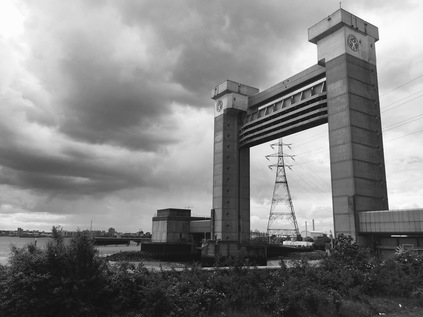
Our walk was almost at an end, and as the ominous towers of the Barking Barrier leered over the industrial units which occupied the site of the thankfully long closed guano works, we left a new place and entered a deleted zone. Creekmouth village once edged up to the banks of the river here, where the Roding and Thames meet. The villagers were supported by a range of fairly horrible work, not least skimming fat from the sewage which washed up on the beach for future use. The terrace of homes housed a small, tight village community that had its origins in the days of the Barking fishing fleet and the ice houses which allowed the boats to head further out into the North Sea, returning with still fresh fish. Creekmouth survived despite the odds, a tiny and isolated community with its own school, post office and pub, but little else. Decline began for the village in 1953 when the great North Sea flood which swept up the Thames caused untold damage to the homes. While people moved back, defiant and uncowed by the waters, the place was never the same. Families began to drift away, and now there's little to see of Creekmouth save for the Crooked Billet pub - now a premier venue for Romanian weddings - and the old school building. Around them is decay, filth and dust - the business of Dagenham moving west to occupy the unwanted land at the meeting of the rivers. We walked out to the barrier, quiet and wind-buffeted as it was on my last visit. In 1878, when the Princess Alice sank off Tripcock Ness after colliding with the Bywell Castle, many of the 650 victims were washed up on the water's edge here at Creekmouth in the following weeks, and it's hard to imagine the horror this tiny community must have suffered as a result of a tide of sewage-bloated bodies at its feet. And so, at this somewhat mournful spot where two rivers met and unimaginable suffering had occurred, our party began to disband - most of us making the walk up to the bus stop to head back to Barking. It had been a surprising and varied walk, with Rob as an excellent guide as before, and while some of the issues of accessing Dagenham's industrial zones had been demystified, there was so much to go back and research now. Perhaps it was possible to get to some of the areas I'd deemed entirely off limits after all?
As I waited for the newly-rechristened EL3 service, the rain began to fall again, steadily soaking the dusty wet pavement and kicking up a loamy petrichor to replace the stink of rotting refuse. It always seems to rain when I'm leaving Creekmouth...
A gallery of images from the Blackwall to West Ham part of the walk is here, while photographs from Dagenham and Barking are here.
Lost::MikeGTN
I've had a home on the web for more years than I care to remember, and a few kind souls persuade me it's worth persisting with keeping it updated. This current incarnation of the site is centred around the blog posts which began back in 1999 as 'the daylog' and continued through my travels and tribulations during the following years.
I don't get out and about nearly as much these days, but I do try to record significant events and trips for posterity. You may also have arrived here by following the trail to my former music blog Songs Heard On Fast Trains. That content is preserved here too.

